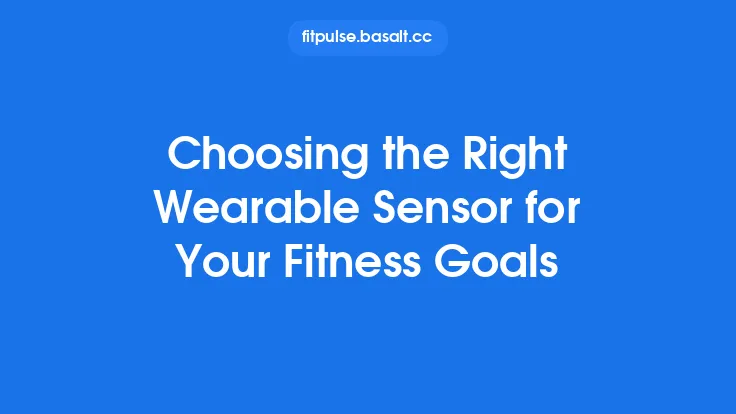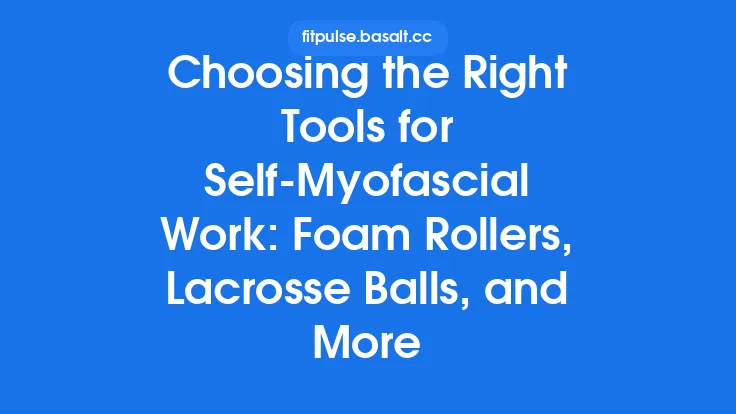Choosing the right goal focus is the cornerstone of a training program that feels natural, sustainable, and rewarding. When your objectives are in harmony with the way you live and what truly drives you, workouts become less of a chore and more of a seamless extension of daily life. Below is a comprehensive guide that walks you through the process of aligning your fitness ambition with your lifestyle patterns and motivational makeup, ensuring that the path you take is both realistic and intrinsically satisfying.
Understanding Lifestyle Variables
Your day‑to‑day reality sets the boundaries within which any training plan must operate. Before you can decide what you want to achieve, you need a clear picture of how you live.
| Variable | What to Examine | Typical Impact on Training |
|---|---|---|
| Time Availability | Number of hours you can consistently allocate to exercise each week, including travel and preparation time. | Determines session length, frequency, and whether you can incorporate longer, lower‑intensity work (e.g., weekend hikes) or need short, high‑intensity blocks. |
| Work Schedule & Shift Patterns | Fixed vs. rotating shifts, remote vs. on‑site work, overtime frequency. | Influences circadian rhythm alignment, recovery windows, and the feasibility of morning vs. evening sessions. |
| Family & Social Commitments | Childcare responsibilities, caregiving duties, social events. | May require flexible programming, home‑based options, or split sessions to fit around obligations. |
| Physical Environment | Access to a gym, outdoor spaces, equipment, climate considerations. | Guides modality selection (e.g., bodyweight circuits for limited equipment, swimming if a pool is nearby). |
| Sleep Quality & Quantity | Average hours of sleep, consistency, presence of sleep disorders. | Directly affects hormonal balance, recovery capacity, and the intensity you can safely sustain. |
| Stress Load & Recovery Resources | Work stress, mental health status, availability of recovery tools (foam rollers, massage, meditation). | High stress may necessitate lower‑impact, stress‑relieving activities (yoga, low‑intensity cardio) to avoid overtraining. |
| Nutritional Patterns | Meal timing, macronutrient distribution, dietary restrictions. | Influences energy availability for different training modalities (e.g., glycogen‑dependent HIIT vs. fat‑oxidation‑focused endurance). |
Action Step: Create a simple matrix (paper or digital) listing each variable and rating it on a 1‑5 scale (1 = minimal impact, 5 = major impact). This visual snapshot will later serve as a reference when matching goal focus to lifestyle constraints.
Decoding Your Core Motivations
Motivation is the engine that keeps you moving when the inevitable obstacles appear. Understanding the type of motivation that fuels you helps you select a goal focus that feels rewarding rather than punitive.
| Motivation Type | Key Characteristics | Typical Goal Focus Alignment |
|---|---|---|
| Intrinsic Enjoyment | You exercise because it feels good, fun, or relaxing. | Activities that emphasize pleasure—dance, trail running, group classes, or sport recreation. |
| Achievement & Mastery | You thrive on measurable progress, personal records, and skill acquisition. | Performance‑oriented goals such as increasing VO₂max, lifting heavier, or mastering a complex movement pattern. |
| Social Connection | The community aspect, accountability partners, or group identity drive you. | Team sports, group training programs, or community challenges. |
| Health Preservation | Long‑term well‑being, disease prevention, and functional independence are paramount. | Consistency‑based goals like maintaining blood pressure, improving mobility, or sustaining daily activity levels. |
| Aesthetic Aspiration | Body composition, physique, or visual transformation are primary drivers. | Structured hypertrophy or fat‑loss programs with clear visual milestones. |
| Stress Relief & Mental Clarity | Exercise is a tool for managing anxiety, depression, or mental fatigue. | Mind‑body practices (yoga, tai chi), low‑intensity steady‑state cardio, or rhythmic activities like rowing. |
Action Step: Reflect on recent workouts that left you feeling energized versus drained. Note the underlying motivation for each. Rank the motivation types from most to least dominant. This ranking will guide the selection of a goal focus that resonates with your psychological drivers.
Mapping Lifestyle and Motivation to Goal Focus
With a quantified view of your lifestyle constraints and a prioritized list of motivations, you can now overlay the two to reveal the most compatible goal focus. The process resembles a decision matrix:
- Identify Overlap Zones – Look for goal categories that satisfy both a high‑rated lifestyle variable (e.g., “limited time”) and a top‑ranked motivation (e.g., “intrinsic enjoyment”).
- Eliminate Incompatible Options – Discard goal focuses that clash with any “5” rating on lifestyle constraints (e.g., a goal requiring daily 2‑hour sessions when you have a “5” for time scarcity).
- Prioritize Feasibility & Fulfillment – Choose the focus that offers the greatest balance between practical feasibility and motivational satisfaction.
Example Mapping:
| Lifestyle Rating (Time = 5) | Motivation Rank (Intrinsic Enjoyment = 1) | Compatible Goal Focus |
|---|---|---|
| Limited time (5) | Intrinsic enjoyment (1) | Short, varied, enjoyable sessions (e.g., 30‑minute HIIT circuits, dance‑based cardio). |
| Variable shift work (4) | Achievement (2) | Flexible performance metrics (e.g., weekly strength test that can be done any day). |
| High stress (5) | Stress relief (3) | Low‑impact, rhythmic activities (e.g., swimming, rowing, yoga). |
Common Goal Focus Categories and Their Fit
Below is a deeper dive into the most frequently encountered goal focuses, paired with the lifestyle‑motivation profiles they typically serve best. This is not an exhaustive list, but it provides a solid reference point for decision‑making.
1. Functional Mobility & Daily‑Living Efficiency
- Ideal For: Individuals with high family or caregiving responsibilities, limited training time, and a health‑preservation motivation.
- Key Training Elements: Joint‑centric mobility drills, core stability circuits, low‑impact functional strength (e.g., kettlebell carries, farmer’s walks).
- Technical Note: Emphasize motor control and neuromuscular efficiency over maximal load; use rate of force development (RFD) as a performance metric rather than absolute weight.
2. Performance‑Driven Endurance (Aerobic Capacity)
- Ideal For: Athletes or enthusiasts with achievement‑oriented motivation, relatively stable schedules, and access to cardio‑specific equipment or outdoor routes.
- Key Training Elements: Periodized VO₂max intervals, lactate threshold runs, long slow distance (LSD) sessions, and sport‑specific pacing drills.
- Technical Note: Apply the polarized training model (≈80% low intensity, 20% high intensity) to maximize aerobic adaptations while preserving recovery.
3. Strength & Power Development
- Ideal For: Those motivated by mastery, with moderate to high time availability, and access to resistance equipment.
- Key Training Elements: Linear or undulating periodization, compound lifts (squat, deadlift, bench press), velocity‑based training for power, and accessory work for injury prevention.
- Technical Note: Track load‑velocity profiles to auto‑regulate intensity; this aligns training stress with daily recovery capacity.
4. Body Composition Optimization
- Ideal For: Aesthetic‑driven individuals who can commit to consistent nutrition tracking and have moderate training flexibility.
- Key Training Elements: Hypertrophy‑focused resistance training (8‑12 rep range), metabolic conditioning (circuit training), and strategic cardio (HIIT or moderate‑intensity steady state).
- Technical Note: Use energy balance equations and macronutrient periodization to fine‑tune caloric intake around training phases.
5. Mind‑Body Integration & Stress Management
- Ideal For: High‑stress lifestyles, intrinsic enjoyment seekers, and those who value mental clarity.
- Key Training Elements: Yoga, Pilates, tai chi, breath‑work, and low‑intensity rhythmic cardio (e.g., rowing, swimming).
- Technical Note: Incorporate heart‑rate variability (HRV) monitoring to gauge autonomic balance and adjust session intensity accordingly.
6. Sport‑Specific Skill Acquisition
- Ideal For: Individuals with a clear sport or recreational activity in mind, moderate to high motivation for achievement, and sufficient time for skill practice.
- Key Training Elements: Technical drills, sport‑specific conditioning, video analysis, and progressive overload of skill complexity.
- Technical Note: Apply deliberate practice principles—focus on specificity, feedback loops, and incremental challenge.
Designing a Training Blueprint Aligned with Your Chosen Focus
Once you have pinpointed the goal focus that best matches your lifestyle and motivation, the next step is to translate that focus into a concrete training blueprint. The blueprint should be modular, allowing for adjustments as life circumstances evolve.
- Define Macro‑Cycles (3‑6 months)
- Set a broad theme (e.g., “Build Functional Strength”) and outline the primary training modalities for each month.
- Include deload or recovery phases that respect your stress and sleep patterns.
- Structure Micro‑Cycles (Weekly)
- Allocate sessions based on time availability (e.g., 3 × 45‑minute sessions, 2 × 30‑minute sessions).
- Ensure each week contains a balance of primary stimulus (e.g., strength) and supportive work (e.g., mobility, recovery).
- Select Exercise Libraries
- Choose exercises that fit the equipment you have and the movement patterns relevant to your goal focus.
- Prioritize multi‑joint movements for efficiency when time is limited.
- Program Intensity & Volume
- Use RPE (Rate of Perceived Exertion) or RIR (Reps In Reserve) scales to self‑regulate intensity, especially when external stressors fluctuate.
- For strength focus, aim for 3‑5 sets of 3‑6 reps at 80‑90% 1RM; for mobility, use 2‑3 sets of 8‑12 reps with controlled tempo.
- Integrate Recovery Strategies
- Schedule active recovery (light mobility, walking) on non‑training days.
- Incorporate sleep hygiene practices and nutrition timing that align with your training windows.
- Progression Mechanics
- Apply the progressive overload principle: increase load, volume, or complexity every 2‑4 weeks, depending on recovery feedback.
- Use auto‑regulation tools (e.g., velocity tracking, HRV) to decide whether to push or pull back on a given session.
Monitoring Progress and Adjusting Focus Over Time
Even the most thoughtfully chosen goal focus may need refinement as life evolves. Continuous monitoring ensures that your training remains a supportive element rather than a source of friction.
- Quantitative Metrics: Track objective data relevant to your focus (e.g., squat 1RM, VO₂max estimate, body fat percentage, HRV trends). Record these monthly to spot meaningful trends.
- Qualitative Feedback: Maintain a brief training journal noting energy levels, mood, perceived stress, and enjoyment after each session. Patterns in these notes often signal when a focus is misaligned.
- Periodic Re‑Assessment: Every 8‑12 weeks, revisit your lifestyle matrix and motivation ranking. Adjust the weighting if a new responsibility emerges or a different motivational driver surfaces.
- Flexibility Triggers: Set predefined “red‑flag” thresholds (e.g., >2 consecutive weeks of RPE >9, HRV drop >15% from baseline, sleep <6 h/night). Crossing a threshold prompts a temporary shift to a lower‑intensity focus or a deload week.
- Goal Focus Pivot: If you notice sustained disengagement, consider a focus pivot—a short‑term switch to a complementary focus (e.g., from strength to mobility) to rekindle motivation while still progressing toward the overarching vision.
Practical Tools and Resources
| Tool | How It Supports Goal‑Focus Alignment | Recommended Platforms |
|---|---|---|
| Lifestyle & Motivation Questionnaire | Captures the variables discussed in the first two sections; outputs a ranked list of compatible goal focuses. | Google Forms, Typeform, or printable PDF. |
| RPE/RIR Mobile Tracker | Enables real‑time intensity self‑regulation without complex calculations. | Strong, FitNotes, or simple spreadsheet. |
| HRV Monitoring App | Provides objective insight into recovery status, guiding day‑to‑day focus intensity. | Elite HRV, WHOOP, or Oura Ring app. |
| Periodization Planner | Visualizes macro‑ and micro‑cycles, ensuring the chosen focus is embedded in the training calendar. | TrainingPeaks, Final Surge, or a printable wall calendar. |
| Progress Photo & Metric Log | Offers visual and numeric evidence of change, reinforcing motivation. | MyFitnessPal (custom logs), Notion, or a physical journal. |
Tip: Pair any digital tool with a weekly “review ritual” (15‑20 min) where you glance at the data, reflect on how you felt, and make a single, actionable adjustment for the upcoming week.
Bringing It All Together
Choosing the right goal focus is less about picking a trendy fitness buzzword and more about constructing a personal contract that respects the realities of your daily life while honoring what truly excites you. By systematically evaluating your lifestyle constraints, uncovering the motivations that light your fire, and mapping those insights onto well‑defined goal categories, you create a training foundation that is both practical and purpose‑driven.
Remember that the process is iterative. As your schedule shifts, as stress levels ebb and flow, and as your internal motivations evolve, revisit the matrix you built at the start. Adjust, refine, and, when needed, pivot—always keeping the core principle in mind: Your training should serve your life, not the other way around. With this evergreen framework, you’ll be equipped to make informed, confident decisions that keep you moving forward, day after day, year after year.




